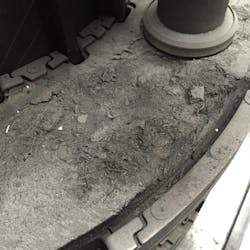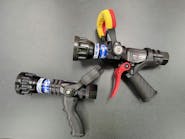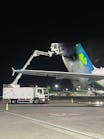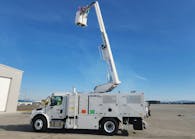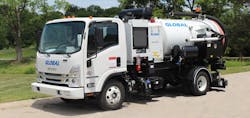Deicing Training and Awareness Can Prolong the Life of Aircraft Brakes and Save Airline Industry Millions
London, UK, January 12, 2017 -- Improved deicing training and awareness of the impact of deice fluid could help prolong the life of aircraft brakes and save the airline industry millions, says industry specialist Phil Randell, managing director of World Aero, experts in aircraft wheel and brakes.
World Aero sees many brakes come through its EASA/FAA Part-145 certified repair station each year destroyed by deicing fluid damage. The damage mainly caused by deicing fluid is from the alkali-metal-salt fluid applied by airports to the runways, which can get transferred on to the wheels (and therefore brakes) when the aircraft is taxiing, taking off and landing. Unfortunately no practical measures can be taken to avoid this damage caused by runway fluids, but if aircraft deicing application methods are carried out correctly, then the damage can be minimized as far as possible. The contamination of aircraft carbon brakes by modern types of deicing fluid can lead to oxidation of the brake discs, causing serious damage to the wear components. Discovery of an oxidised brake, seen by line maintenance technicians during routine wheel changes, mean the brake must then be removed from the aircraft altogether, with premature removal having costly implications for the operator, as well as an AOG risk. World Aero has seen a number of brakes where high remaining wear is left on the heat sink, but the oxidation is severe and the only option is to replace the carbon heat sink. It is of course a particular issue in countries affected by extreme, prolonged cold weather where the use of de-icing fluid is more prevalent.
The vital process of deicing ensures that aircraft are free of ice, snow or frost before take-off. The one- or two-step procedure involves the application of one or two types of fluid to the aircraft surfaces by hose from a deicing vehicle. It is a time-sensitive task, with operatives regularly feeling under pressure to get the job completed quickly so that the aircraft can get back in the air as soon as possible after application. In addition to this, communication can be difficult, with operatives wearing ear defenders and often carrying out the task in the early hours of the morning. Furthermore, particular fluids must be reapplied if a certain time has lapsed before the pilot has taken off, meaning if there is a long queue for take-off the process must be repeated, increasing the exposure of wheels and brakes to the harmful fluid
Having previously worked at London City Airport as a Line Maintenance Engineer certifying aircraft as ready for flight after deicing, Randell knows first-hand the difficulty of the process and the temptation to over-apply aircraft with fluid in order to ensure that deicing is effective: “The process involves covering the aircraft with de-icing fluid in order to minimise the risk of missed areas, meaning that wheels and brakes are often sprayed directly rather than avoided as they should be.”
Randell explains: “The issue is particularly prevalent in Boeing 747-400 carbon brakes and World Aero has seen a large number of these prematurely removed from the aircraft and later scrapped due to oxidation. This costs the airlines a considerable amount with the replacement heat sink exchange ranging from $30,000 to $50,000 depending on the agreement in place with the OEM, as well as the cost of the premature removal and workshop costs. This often makes the difference between repairable and non-repairable on the older generation aircraft due to the current market value of the brake. In addition to this, OEMs must scrap the removed heat sink due to oxidation, causing there to be no acceptable core heat sink, further adding to the replacement cost.
“The issue can also be more prevalent in aircraft fitted with brake fans, including BAe146 and A320, due to deicing fluid being sprayed and drawn into and across the brakes during turnaround. Fortunately newer aircraft avoid complications as a more advanced type of carbon is used in the brakes, which can better withstand the destructive effects of deicing fluid,” Randell goes on. “767-300 aircraft used to be badly affected however Honeywell released a new carbon heat sink with improved carbon elements. Of the 50-60 Messier-Bugatti-Dowty brakes we see annually, only a very small number of brakes have been removed prematurely due to oxidation.”
Simple improvements to deicing training could create awareness of correct work practices and highlight the costly implications of the procedure being carried out incorrectly, Randell advises. “Deicing training often concentrates on the importance on covering the aircraft with deicing fluid in order to ensure effectiveness,” says Randell, “but when deicing by hand, training could be improved to give further awareness to the airport operatives carrying out the procedure to highlight protecting the more sensitive parts of the aircraft, such as the pitot heads, equipment cooling inlets, and engine inlets, as well as of course the wheels and brakes.”
As most aircraft wheels and brakes are under the body or wing, they have a level of protection, so if not sprayed directly, damage can be avoided, with a minimal amount of drip down to the wheels to be expected. Checking for damaged brakes is done when removing the wheels for tyre change, when a check on the brakes can be performed to observe for crumbling of the carbon components, especially of the pressure plate located closest to the pistons, which indicates oxidisation of the heat sink.
“With improved deice training and awareness of the effects of deice fluid on brakes,” Randell concludes, “operators would be able to save significant sums over the lifecycle of an aircraft by having fewer, faster and more cost effective repairs, ensuring a longer life for brakes and avoiding expensive replacement parts.”
About World Aero: Established in 1999, World Aero are experts in aircraft wheels and brakes, providing aircraft wheel and brake component repair, overhaul, parts sales, parts exchange and inventory management for international aviation customers; from commercial airline fleets to corporate jets. World Aero is a multi- release EASA, FAA and additionally TCCA certified repair station.
